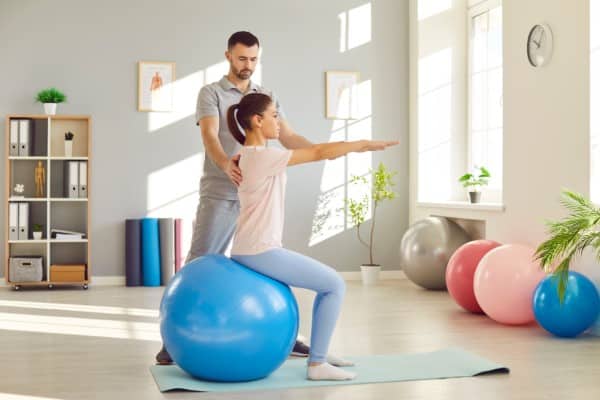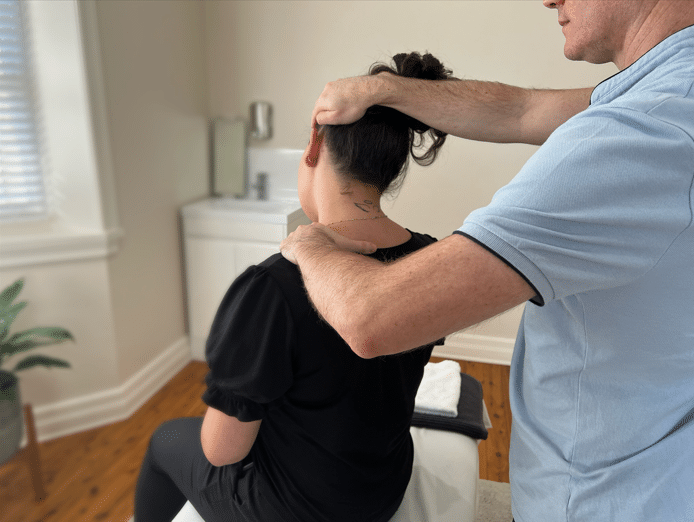- 02 9712 1736
- [email protected]
- 212 Great North Road, Five Dock, NSW 2046
- Open 7 days a week
Experiencing discomfort from long hours spent at your computer or frequently looking down at your phone? This posture-related issue, known as “tech neck,” is becoming more common. Tech neck results from poor posture over time, leading to muscle strain and discomfort. Although Botox injections are an increasingly popular option to relieve muscle tightness from this chronic issue, they only provide temporary relief, masking the problem rather than addressing its cause. In this article, we’ll explain what tech neck is and share practical lifestyle changes and advice to help you prevent it—no Botox needed.

Tech neck is a term for pain and inflammation in the neck and upper back caused by spending too much time on devices. When we constantly look down at our phones, tablets, and laptops, our neck muscles have to work harder. Over time, this frequent downward gaze leads to stiffness and tightness in these muscles. The position also puts extra pressure on the spinal joints in the neck, which can cause discomfort and even lead to long-term strain.
Poor posture from tech neck doesn’t just cause physical discomfort; it can also impact how we look and feel about ourselves. Many people start to notice changes in their posture, which can affect their confidence and self-esteem. With more people spending hours each day on their devices, understanding how tech neck develops—and learning ways to prevent and manage it—is more important than ever.

Tech neck occurs mainly as a result of frequently looking down at screens for long periods of time. Poor posture associated with this activity puts extra strain on the muscles in the neck and stresses the spinal joints. When you have a forward head posture, the muscles in your neck and upper back are forced to work harder. The further your head moves in front of your torso, the more weight the neck has to support. It’s similar to holding a bowling ball close to your chest versus holding it with your arm stretched out in front of you. When the bowling ball is close to your body, it feels lighter. But when it’s extended, it becomes much heavier and more challenging to hold. This extra stress and strain on your muscle and your spine results in pain and stiffness over time.
The risk of developing tech neck increases with the amount of time spent in this poor posture. The more you maintain this position, the more your body adapts to it, leading to discomfort and tension. Consider how much time you spend each day in one position without moving. Are you sitting at your desk for hours on end?
Botox injections might seem like an easy solution for tech neck, but they only offer temporary relief. Typically, the effects of Botox last around three to four months. This means that to remain pain-free, a person would need to schedule regular and often expensive treatments. While Botox can help relax tight muscles, it doesn’t get to the root of the problem. The real causes of tech neck, like poor posture and too much time spent looking down at devices, remain unchanged. In this sense, Botox acts as a band-aid solution—it hides the symptoms without truly fixing the underlying issue.
There are also potential side effects from using Botox injections regularly, which makes it even more important to focus on long-term solutions. Addressing the root causes of tech neck can provide lasting relief without the need for ongoing treatments. By improving posture, setting up an ergonomic workspace, and taking frequent breaks, you can reduce the strain on your neck and shoulders. These adjustments can make a significant difference in preventing tech neck, allowing for a healthier approach that doesn’t rely on temporary fixes like Botox.
Preventing tech neck requires a well-rounded approach that includes focusing on good posture, maintaining an ergonomic workspace, and taking regular breaks. Each of these strategies helps reducing strain on the neck muscles and lower the chances of developing discomfort and tension in the neck area. By incorporating these practices into your daily routine, you can significantly lessen the effects of tech neck and improve your overall well-being.
Good posture is key to preventing tech neck. Here are some tips to maintain proper posture while using devices:
This helps to prevent muscle contraction and reduces the risk of developing poor postural habits. Prolonged device use can significantly contribute to poor posture, increasing the risk of tech neck and subsequent pain and discomfort. Mindful posture and small adjustments can alleviate the strain and discomfort associated with tech neck.

Taking regular breaks can significantly reduce the risk of developing tech neck. Short breaks every 15 to 30 minutes can help improve blood circulation and reduce tension in the neck. Setting reminders to take breaks can encourage more frequent movement and reduce the risk of neck pain.
Incorporating brief walks and stretches during work hours can alleviate neck tension. Performing neck rotations and other exercises can help maintain muscle flexibility and prevent stiffness.
Regular breaks and neck exercises can effectively combat the strain from prolonged device use.

Creating an ergonomic workspace involves adjusting your chair height and monitor position to reduce neck muscle strain. Using a standing desk can promote better posture and reduce the strain on your neck and lower back when properly adjusted. Alternating between sitting and standing positions with a sit/stand desk can also help minimize strain.
Investing in an adjustable monitor can help maintain a neutral neck position, minimizing strain during work. Ensure that the top of your screen is at eye level to avoid looking down for long periods. Proper desk setup, including monitor height and chair support, is crucial for preventing neck strain and maintaining good posture.
In summary, preventing and addressing tech neck requires a comprehensive approach. While Botox offers a temporary fix, it does not address the root causes of tech neck. Instead, focusing on maintaining good posture, setting up an ergonomic workspace, and taking regular breaks are more effective long-term solutions.
Forest Lodge, Annandale, Glebe, Leichhardt, Balmain, Haberfield, Canada Bay, Rozelle, Rodd Point, Wareemba, Stanmore, Petersham, Lilyfield, Hunters Hill, Enfield, Cabarita, Mortlake, Rhodes, Burwood Heights, Birchgrove, Gladesville, Huntleys Point, Abbotsford, Ashfield, Croydon Park, Croydon, Chiswick, Russell Lea, Burwood, Strathfield, Concord, Drummoyne, North Strathfield, Liberty Grove, Dulwich Hill, Lewisham, Camperdown, Ashbury, Homebush, Homebush West, Woolwich, Henley, Summer Hill, Sydney Olympic Park


About
Five Dock Osteopathic & Chiropractic is located in Canada Bay, in Sydney’s Inner West. Servicing suburbs including Burwood, Croydon, Drummoyne, Five Dock, Haberfield, Concord, Abbotsford, Chiswick, Leichhardt, Wareemba, Russell Lea, Summer Hill, Strathfield.
Clinic hours
Monday, Tuesday, Thursday 7AM – 7PM
Wednesday, Friday 7AM – 6PM
Saturday 7AM – 2PM
Sunday 8AM – 2PM
Contact details